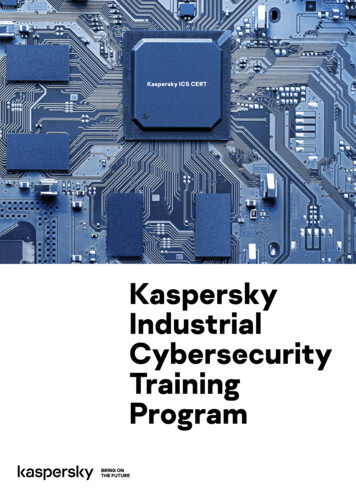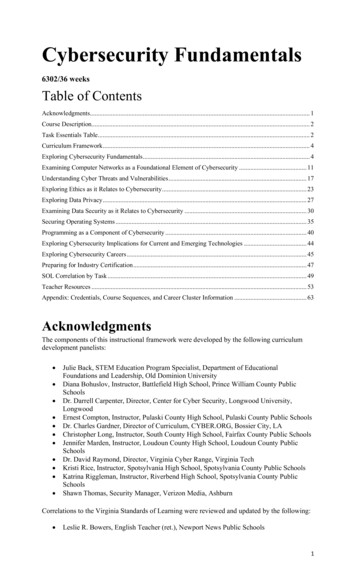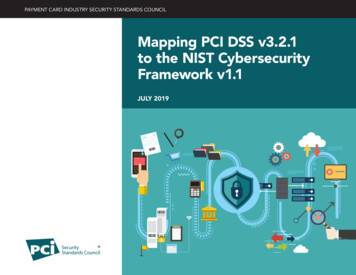
Transcription
Volume 2 AprilIndustrialCybersecurity An expanding attack surfaceputs plants at risk The next big step forEtherNet/IP Bridging the IT/OTcybersecurity divide Understanding USB interfacethreats Microsegmentation andedge securityA subsidiary of the InternationalSociety of Automation
AUTOMATION 2020 VOL 2 APRILIntroductionIndustrial CybersecurityInformation technology (IT) and operational technology (OT) departments approachoperations in very different ways. While innovation, upgrades, and a global view arecommon in IT, industrial OT organizations are mainly focused on getting a system to runreliably with as few changes as possible. So, it makes sense that IT and OT approaches tocybersecurity are different as well. IT environments were always connected to a networkand the Internet, so security risks have been top of mind for decades. OT departments, onthe other hand, have relied on “air gaps” to separate industrial networks from the rest of theworld. With digitalization and ubiquitous connectivity, IT and OT have converged. And thereis a lot of cybersecurity learning that needs to be shared.In this edition of AUTOMATION 2020 from Automation.com, find out how to bolsterbusiness resiliency in the face of cyberthreats, how to protect against threats to industrialcontrol systems, the latest on USB port intrusion threats, the next big step in EtherNet/IP security, and more. Formerly called Advancing Automation, this ebook series includessponsored and curated articles from a variety of experts on industrial cybersecurity.Subscribe online to not miss an issue of these guides to best practices and cutting-edgeinsight for automation professionals.A subsidiary of the InternationalSociety of Automation2
Table of ContentsAUTOMATION 2020 VOL 2 APRILCYBERSECURITYPage 5Back to USB SchoolBy Eric D. Knapp, Honeywell Connected EnterpriseUSB attacks blur the line between a network threat and a localphysical threat.Page 9The Increasing Attack Surface: IndustrialEnvironments at RiskBy Michael Rothschild, TenableIndustrial organizations are facing cybersecurity risks to onceseparate IT and OT systems. Find out the steps you can take toprotect against industrial control systems threats.Page 14Ready for the Next Big Step in EtherNet/IP?By John S. Rinaldi, Real Time AutomationCIP Security over EtherNet/IP may soon become an essentialpart of all EtherNet/IP adapters, supporting secure transport.Page 21Bridging the IT and OT Cybersecurity DivideBy Peter Vescuso, DragosExperts from both domains can bolster business resiliency nomatter what the cyberthreats target.Page 28Security at the Edge with MicrosegmentationBy Courtney Schneider, Waterfall Security SolutionsWhen IIoT deployments present unacceptable physicalconsequences, we need strong protections for the edge devices.A subsidiary of the InternationalSociety of Automation3
Interested in learning how to better secure your assets and operations safely,while your employees work remotely? Visit www.becybersecure.comto learn more about Honeywell Forge Cybersecurity Solutions.
AUTOMATION 2020 VOL 2 APRILBack to USB SchoolUSB attacks blur the linebetween a network threat anda local physical threatBy Eric D. Knapp, Honeywell Connected EnterpriseAlthough it has been a while since I posted anything about USBsecurity, I have not stopped obsessing about it. Almost a year ago,when the world’s biggest health crisis was the voluntary inhalationof vaporized nicotine, I spoke about how easy it was to use USB devicesas attack vectors.There was a small moment during that presentation when I talked about the scope of theUSB vector. I mentioned it almost offhandedly, but it has been nagging at me ever since. WhatI said was, “every USB interface can be home to a whole network of devices, all communicatingin a way that is eerily similar to Ethernet. And because almost everything out there todayA subsidiary of the InternationalSociety of Automation5
AUTOMATION 2020 VOL 2 APRILhas at least one if not many USB interfaces on it, the USBprotocol essentially extends every one of our networks intosomething exponentially bigger.”I probably did not say it that eloquently, but the pointwas that USB devices and hosts communicate over a network(the “bus” of universal serial bus), and that in turn is connectedto every other network. Now vaping has taken back seat to aglobal pandemic that has everyone doing everything possibleremotely . . . and I keep thinking about what this means for thethreat landscape, and specifically for USB threats.So while I felt pretty smart back at RSA Conference, it istime to go back to school—on the bus? Get it? Things havechanged a lot in just one year. And, as the security industry hascontinued to evolve at its typical lightning speed, I have beenthinking back to that offhand comment about USB being anetwork, and how that network could potentially interact withother networks.The USB protocol essentially extendsevery one of our networks into somethingexponentially bigger.My worry is that everything out there in the world todayis connected, and everything out there in the world todayhas USB. Because a single USB host can connect to dozensof logical interfaces, and each of those can have multiple endpoints, there could be any number of things on our networksthat we do not really know about. It is like every traditionalnetwork node is carrying another tiny network around withit. If there was an easy way for an attacker to move freelybetween the Ethernet network and the USB bus, it wouldmean there is a new softer, less secure “edge network”coupled to our infrastructure that we are not even paying anyattention to.It is a daunting theory, and unfortunately onethat in the past year has become a reality. Sure, it wasalways technically possible, but over the past year it has becomenot only real but really easy.At DEF CON 2019, there were two new wireless USBplatforms available for purchase (that I am aware of), and atleast one more platform was introduced in one of the demosessions. USB attacks are becoming more interactive, and theyare starting to blur that line between a network threat and alocal, physical one.A subsidiary of the InternationalSociety of Automation6
AUTOMATION 2020 VOL 2 APRILTo show just how easy it can be, I wrote this article in notepad remotely, by sendingcommands over a network to an O.MG cable—a clever and powerful pen-testing tool that hidesa tiny server inside a USB cable. That cable was connected to my laptop (as a human interfacedevice, or HID), but also to Wi-Fi. It is a silly example, but one that easily proves that you canremotely influence computers via locally attached USB devices.What can we do about it? Well, we can and should continue to experiment and learn.To that end, we have been planning on hosting a USB threat challenge later this summer(although that may need to be virtual now, or postponed) to see how clever the hackingcommunity can get.My personal hope is to see just how far we can push the boundaries using USB as avector. Armed with that knowledge, we can find new and better ways to cope with this rapidlydeveloping threat vector.ABOUT THE AUTHOREric D. Knapp (@ericdknapp) is a Senior Fellow at Honeywell ConnectedEnterprise, where he drives advancements in industrial cybersecurity asthe leader of the Global Research, Analysis, and Defense team. Knapp isa recognized expert in industrial control systems cybersecurity. He is theauthor of Industrial Network Security: Securing Critical Infrastructure Networks for Smart Grid, SCADA, and Other Industrial Control Systems, andthe co-author of Applied Cyber Security for Smart Grids. Knapp has morethan 20 years of experience in OT cybersecurity and holds multiple patents in the areas of risk management, asset protection, and secure datatransfer. Prior to Honeywell, Knapp held technology leadership positionsat NitroSecurity, Intel Security/McAfee, and Wurldtech, and is active onnumerous industry boards and committees. Knapp’s research and development efforts are the result of his never-ending quest to improve thefield of industrial cybersecurity.Online LearningLearn more about ways to protect industrial control systems from today’s most commoncyberattacks, including USB port intrusion and phishing. The latest webinar hosted by Honeywelland Automation.com is entitled “9 Key Ways to Protect Yourself from the #2 Threat to OTEnvironments” and is available on-demand on Automation.com. Additional materials can befound on Honeywell’s BEcybersecure.com website.A subsidiary of the InternationalSociety of Automation7
Complete VisibilityGo deeper than simply listening tonetwork traffic by actively queryingdevices in their native protocols.Proactive Risk-BasedInsights Into VulnerabilitiesWith real-time information you’ll alwaysknow your risk profile and be ready toaddress new threats as they emerge.Unified OT and IT SecurityUnify your OT and IT security witha single vendor in an integrated solution.Gain Full Visibility, Security and Control with Tenable.ot:Tenable.ot Is the LeaderIn Industrial Cybersecurity,with Patented ActiveQuery TechnologyLearn about the 7 Most CommonUnsafe Gaps In IndustrialCybersecurity and How YouCan Protect Against ThemVIEW INFOGRAPHICREQUEST A DEMOThe 5 Things You Need to KnowAbout IT/OT ConvergenceWATCH WEBINARCOPYRIGHT 2020 TENABLE, INC. ALL RIGHTS RESERVED. TENABLE, TENABLE.IO, TENABLE NETWORK SECURITY, NESSUS, SECURITYCENTER, SECURITYCENTERCONTINUOUS VIEW AND LOG CORRELATION ENGINE ARE REGISTERED TRADEMARKS OF TENABLE, INC. TENABLE.SC, TENABLE.OT, LUMIN, INDEGY, ASSURE, ANDTHE CYBER EXPOSURE COMPANY ARE TRADEMARKS OF TENABLE, INC. ALL OTHER PRODUCTS OR SERVICES ARE TRADEMARKS OF THEIR RESPECTIVE OWNERS.
AUTOMATION 2020 VOL 2 APRILThe Increasing Attack Surface:Industrial Environments at RiskBy Michael Rothschild, TenableIT professionals will look at you like you arecrazy. Tell them: “The computer running theelectrical grid has not been touched in 20years.”Or tell the IT people in a bottling facilitythe computer that runs the plant was lastmoved back during Y2K preparations.They simply will not believe you.Why? Because IT and operationaltechnology (OT) approaches to operationsare polar opposites. While innovation and security form IT’s foundation, OT is more aboutletting a system run reliably and with as little change as possible. The chasm between IT andOT has traditionally been wide, but it won’t be for much longer.Where did it all begin? IT and OT typically never intersected. IT environments were alwaysconnected to the Internet, intranet, and beyond. As a result, security risks were a concern forarguably more than three decades. There was an overarching business and technological needfor complete visibility, security, and compliance, mostly because just one attack could shakecustomer faith, shareholder confidence, and ultimately put a business at risk.This environment required professionals to constantly evaluate technology and swap it outwith a change out schedule generally every 18–36 months—and that was just to stay ahead ofthe “breach curve.”Facing new complex threats toonce-separate IT and OT systems,industrial organizations are“de-siloing” to secure their globalenvironmentOT life cycle 10–15 yearsIT life cycle 12–18 monthsFigure 1. The difference in technology change outs between IT and OT equipment became known as the“life-cycle disparity.”A subsidiary of the InternationalSociety of Automation9
AUTOMATION 2020 VOL 2 APRILOT environments were a different beast. Whether it was the industrial controller runningthe cooling tower, purification process, blast furnace, electrical grid, or any number of things,these “old reliable” systems were completely disconnected from everything else.Security was not a concern, and compliance was not an issue, because “air gaps” separatedindustrial networks from the rest of the world. Industrial networks were not connected to businessnetworks or the Internet. Because of this “set it and forget it” attitude, technology seldom—ifever—needed switching out. It was not uncommon for OT equipment to be as old as the plant.A new connected worldIn today’s connected world, “air gapping” is no longer an operationally feasible solution. Manypundits claim the IT and OT chasm started changing when the notion of the Internet of Things(IoT)—or more appropriately the Industrial Internet of Things (IIoT)—started ramping up.Industrial and critical infrastructure environments now wholly adopt connecting IT andOT, while also leveraging IoT technology to realize efficiencies and cost savings across the entireorganization.Global connectivity makes our lives easier in many ways. We need not go any furtherthan our smartphone to summon practically anything we want. So too, in the world of criticalinfrastructure and manufacturing, the ability to have instant access to production lines,manufacturing facilities, and electricity-generating plants enables up-to-the-minute metrics,full visibility, and the ability to control changes from anywhere—with less effort and cost.Need for anywhere accessNight Dragon2010Red October20122011StuxnetAuroraBlack avexSteel Mill AttackLockerGogaDtrackLemon DuckEKANSWannacryTritonPetya20182017Op Ghoul20202019Shamoon3VPNFilterAlert (TA18-074A)TBAFigure 2. A history of some of the major attacks on OT infrastructures. Courtesy of TenableA concrete manufacturing company found it took two days to fire up its blast furnace to theright temperature. What better way of monitoring the progress than over a single pane of glassgraphical user interface from anywhere in the world?Connecting and interconnecting the electrical grid between suppliers was contributory incausing great blackout of 2003 where almost the entire Northeast was without power due to acascading failure. Systems could not talk to each other and the visibility needed to thwart thisfailure was simply not there.In each of these cases, businesses found practical applications to connect things to theweb. The results were huge benefits from cost saving, visibility, and efficiency perspectives.These cases heralded the convergence of once separate IT and OT systems, as well asrapid adoption of IoT technology by industrial organizations. But convergence created a newA subsidiary of the InternationalSociety of Automation10
AUTOMATION 2020 VOL 2 APRILproblem—connected industrial controllers had little in the way of defense against cyberattacks.Little did people know that they would quickly find OT devices in the crosshairs of attacks thatcould alter the way we live.Cyber convergence challengesThe increase in the number of cyber incidents on industrial control system (ICS) networks is areality we can no longer ignore. Few argue against the attack surface changing to encompassboth IT and OT. Because these two different worlds are now connected, an attack that starts onan IT environment can quickly move to an OT environment and vice versa.Lateral movement is a preferred attack methodology for hackers. It is relatively easy tofind a weak link in the system, leverage it as a point of entry, and then quickly own the entirenetwork. Much like when one person sneezes in a room, a bunch of people can get a cold, sotoo our interconnected systems across IT/OT environments share “cyber germs” that can takedown an entire system.Initial physical or virtualinfiltration to the networkEstablishing a beachheadin one of the assets in thenetworkInitiating reconnaissanceactivity to map out thetargets and vulnerabledevices or systemsPropagating to otherassets to reach theareas of interestThe “last mile” of the attackwhich can disrupt, changeor destroy the sourcing ormanufacturing processFigure 3. Typical cross-platform attack etiologyProtection against ICS threatsBringing these two substantially different IT and OT worlds together is a challenge. To addressnew complex threats that broaden attack surfaces and increase the amount of attack vectors,organizations are “de-siloing” their approach to securing their global environment.What is necessary to help address clear and present needs?1.360-degree visibility: Attacks can easily propagate in an IT/OT infrastructure. With a singleplatform to manage and measure cyberrisk across OT and IT systems, you will gain completevisibility into the converged attack surface. You will also want a solution that nativelyintegrates with leading IT security and operational tools, such as a security informationand event management (SIEM) solution, log management tools, next-generation firewalls,and ticketing systems. Together, this builds an ecosystem of trust where all your securityproducts can work together as one to keep your environment secure.2. Threat detection and mitigation: Ensure your OT security solution leverages a multidetection engine to find high-risk events and behaviors that can impact OT operations.These engines should include the following detection capabilities: Policy-based: Activate predefined policies or create custom policies that whitelist and/or blacklist specific granular activities that may indicate cyberthreats or operationalmistakes that trigger alerts. Policies can also trigger active checks for predefinedsituations. This is crucial for discovery of risky events that do not rise above thestatistical noise (e.g., malware, reconnaissance activity, querying device firmwareversions from a human-machine interface [HMI]). Behavioral anomalies: Where the system detects deviations from a network trafficbaseline based on traffic patterns. Pattern baselines include a mixture of time ranges,A subsidiary of the InternationalSociety of Automation11
AUTOMATION 2020 VOL 2 APRIL protocols, devices, etc. Among other things, it allows detection of suspicious scansindicative of malware or rogue devices in your network. It will also help detect Zeroday attacks where no policy or signature has yet been created.Signature updates: By leveraging a crowdsourced signature database (such asSuricata), you can detect attacks throughout all stages and get alerts with contextabout suspicious traffic that can indicate reconnaissance, exploits, installed malware,lateral propagation, and more. The threat detection engine should ingest newsignature updates to address new threats as they evolve.Industrial and critical infrastructure environments are increasingly converging ITand OT, while also leveraging IoT technology to realize efficiencies.Asset inventory and active detection: Your OT security solution should provideunparalleled visibility into your infrastructure—at the network level down to the devicelevel. It should combine native communication protocols to actively query IT, as well asOT devices in your ICS environment, to identify all activities and actions, as well as gainingdeep situational awareness across your network and devices in your network.4. Risk-based vulnerability management: Drawing on comprehensive and detailed IT andOT asset tracking capabilities, your OT security solution should generate a prioritized listof vulnerabilities and risk levels for each asset in your ICS network. These reports shouldinclude risk scoring and detailed insights, along with mitigation suggestions. Vulnerabilityassessments should include parameters, such as firmware versions, relevant CVEs,proprietary research, default passwords, open ports, installed hotfixes, and more.5. Configuration control: Should track any changes made to OT assets, whether they areuser executed or malware based via the network or by local connection. This capabilityshould provide a full history of device configuration changes over time, includinggranularity of specific ladder logic segments, diagnostic buffers, and tag tables. Thisenables administrators to establish a backup snapshot with the “last known good state” forfaster recovery and compliance with industry regulations.Collaboration between IT and OT can help mitigate risks and vulnerabilities that traversethese two unique and now deeply intertwined infrastructures. By combining a strong ITsecurity posture with an equally strong OT posture, industrial organizations can protect ICSnetworks from external and internal cyberthreats—now and in the future.3.ABOUT THE AUTHORMichael Rothschild, with more than 20 years of security experience,is the senior director of OT Solutions at Tenable. He is a past professorof marketing and has published a number of works on the topic. Hecurrently occupies an advisory board seat at Rutgers University. With apassion for healthcare, Rothschild is a volunteer EMT and deputy chiefof his local ambulance corps. He also teaches for the American HeartAssociation.A subsidiary of the InternationalSociety of Automation12
AUTOMATION 2020 VOL 2 APRILReady for the Next BigStep in EtherNet/IP?Get to know CIP Security, a securestandard for the transport of EtherNet/IPmessages over an industrial networkBy John S. Rinaldi,Real Time AutomationEncryption dates as far back as the Spartans of ancient Greece and possibly even further.Like every army before and after them, the ancient Spartans needed a mechanism tosend confidential messages to field commanders. Their solution was to secure theircommunications by wrapping a long piece of leather around a wooden rod and writing amessage vertically on the leather. When unwrapped from the wooden rod, you had a piece ofleather inscribed with a series of seemingly senseless letters. The leather could then be carriedto the intended recipient who, knowing the diameter of the rod (the “key”), would wrap theleather around another rod of the same diameter and read the message. If it fell into enemyhands, anyone lacking the “key” would have a nonsensical series of letters. Of course, this wasfar from foolproof; brute force decryption—trying wooden rods of different diameters—couldeventually decode the message, but it was ingenious for that era.A subsidiary of the InternationalSociety of Automation14
AUTOMATION 2020 VOL 2 APRILWhile we are a long way from wrapping wooden rods with strips of leather, the need forconfidentially exchanging messages has not changed. Today, we have Ethernet systems on ourfactory floor exchanging messages between controllers and end devices. In the past few years,these Ethernet systems have been extended to link enterprise and cloud applications to thefactory floor.Unfortunately, extending connectivity beyond the factory floor has increased thevulnerability of those systems to cyberattacks. Attackers, sensing an opportunity, have shiftedtheir attention from personal computers and servers to the world of factory automation.Because the majority of these attacks are not publicized, no one knows for certain howmany plants have had their servers locked, important data stolen, messages altered, andprogrammable controllers hijacked.In the past, it was not uncommon to have insecure controllers directly connected to theInternet. Over the years, these controllers have been removed, updated, or replaced with newerversions that are more cybersecure. Most manufacturing installations have also added defensein-depth strategies that make it much more difficult to get to controllers and I/O networksfrom the outside. What is often still open and vulnerable, though—if you can get to it—is theinside, the I/O network side of programmable controllers.If you can get access to an EtherNet/IP, Modbus TCP, or PROFINET IO network, you canoften have free reign to create all kinds of havoc. There is generally nothing stopping you fromaccessing the controller tags over that network: turning pumps on or off, increasing motorspeeds, or opening and closing valves.Even with strong cybersecurity protection from the outside, factory floor systems can becompromised from the inside. Most facilities have an army of Internet of Things (IoT) vendors,automation vendors, technicians, system integrators, and corporate engineers who come onsite and knowingly or unknowingly bring viruses, malware, time bombs, and worse into yourplant and onto your critical I/O networks.If you can get access to an EtherNet/IP,Modbus TCP, or PROFINET IO network, youcan often create all kinds of havoc.A subsidiary of the InternationalSociety of Automation15
AUTOMATION 2020 VOL 2 APRILEtherNet/IP, the Ethernet implementation of the CommonIndustrial Protocol (CIP), was never designed as a securecommunications transport. It is designed for ease of use andflexibility. Anyone can make connections to an EtherNet/IPadapter and execute any operation, including a reset of the device.This makes EtherNet/IP a very insecure communications protocol.In light of this, ODVA recently began deployment of CIPSecurity for EtherNet/IP. CIP Security is a secure standard for thetransportation of EtherNet/IP messages. It allows communicationbetween trusted entities, and disallows communication betweenuntrusted entities on an EtherNet/IP network.This article introduces CIP Security for EtherNet/IP. Itexplains what is meant by CIP Security and describes thetechnologies that it is based on, the new CIP objects that arerequired, and how developers and end users should moveforward in this era of secure EtherNet/IP.What is CIP Security?CIP Security is designed to protect not only EtherNet/IPadapter devices (end devices) from access by unauthorizedparties, but also to protect programmable controllers.Attackers have noted that programmable controllers are moreresilient to outside entities (Internet attacks) than to insideentities (I/O network attacks).The ODVA designed CIP Security to protect programmablecontrollers and devices on I/O networks from attacks originatingon those networks. At first blush, attacks on the I/O networkseem unlikely. I/O networks are not generally connected tothe Internet, so what is the concern? In practice, these kinds ofattacks are not all that unlikely.Contractors come and go from a facility and connect tonetworks with laptops that may be compromised. Employeesmay fail to disable open ports on switches. Some employeesknowingly engage in sabotage. There is a myriad of ways forattackers to get access to your I/O network. CIP Security isdesigned to increase the immunity to such attacks. The secureEtherNet/IP transport provides the following security attributes: Authentication of the end points: ensuring that thetarget and originator are both trusted entities. End pointauthentication is accomplished using X.509 certificates orpreshared keys. Message integrity and authentication: ensuring that themessage was sent by the trusted end point and was notmodified in transit. Message integrity and authentication isaccomplished via TLS message authentication code (HMAC).A subsidiary of the InternationalSociety of Automation16
AUTOMATION 2020 VOL 2 APRIL Message encryption: optional capability to encrypt the communications, provided by theencryption algorithm that is negotiated via the TLS handshake.A fundamental design tenet is that not all devices on an EtherNet/IP network needthe same level of protection. Some devices are less critical, and some are more critical to anautomation system. The required protection is not identical; CIP Security defines two securityprofiles to offer that different level of protection.EtherNet/IP Confidentiality Profile provides secure communications by requiringauthentication and data integrity for all EtherNet/IP messages. Authentication means that anEtherNet/IP device identity is verified to be the device it claims to be. Data integrity means thatthe data within the EtherNet/IP message can be relied upon to be accurate and consistent.EtherNet/IP Authorization Profile goes one step further than the Confidentiality Profile. Itprovides user authorization. With the authorization profile, an application requesting an actionlike opening or closing a valve would have to be authorized to take that action.EtherNet/IP Devices that do not support CIP Security can coexist with devices that supportthe Confidentiality or Authorization Profiles.CIP Security is designed to protect not only EtherNet/IP adapterdevices (end devices) from access by unauthorized parties, butalso to protect programmable controllers.The two CIP Security trust modelsA trust model is a very important consideration in manufacturing system security. The trustmodel is the collection of rules that govern how a device decides to trust another device. A trustmodel that is too soft (flexible) cannot provide the integrity, confidentiality, and authenticitythat you need. A trust model that is too hard (inflexible) becomes such a burden on dailyoperations that it lowers your productivity. But a trust model that is “just right” provides youwith that integrity, confidentiality, and authenticity without impeding legitimate entities thatneed to communicate and keep product flowing out the door.CIP Security supports two trust models: preshared key (PSK) and certificates. Both areuseful. Both have advantages and disadvantages.PRESHARED KEY (PSK): Preshared key is an uncomplicated system that works well insmall systems. Private key sharing operates very simply. A private key is known and shared byall the devices in a network. The key is used to encrypt messages. Any device that knows theprivate key is authenticated and able to encrypt and decrypt messages. For added protection,the key is changed at some set interval, sometimes as part of a maintenance cycle.X.509 CERTIFICATES: X.509 certificates are a standard way for two devices to securelycommunicate. Each device has a certificate identifying the entity issuing the certificate. Thatentity can be the device itself (self-signed certificate), the vendor who manufactures the device,or some outside authority that is trusted by other devices with which it wants to communicate.The device receiving the certificate can send encrypted messages to the originator byencrypting the message with the public key in the certificate. The private
a recognized expert in industrial control systems cybersecurity. He is the author of Industrial Network Security: Securing Critical Infrastructure Net-works for Smart Grid, SCADA, and Other Industrial Control Systems, and the c









